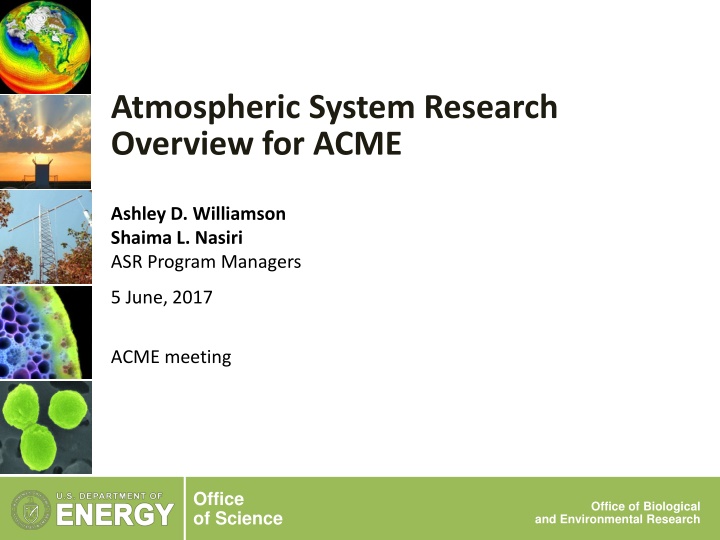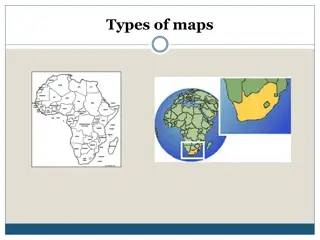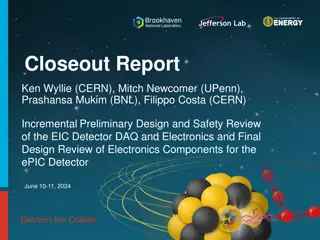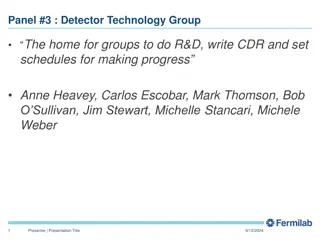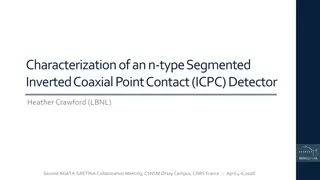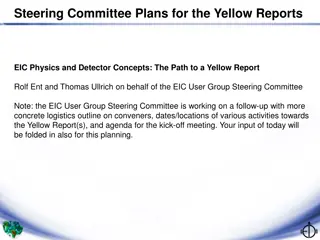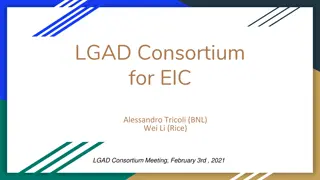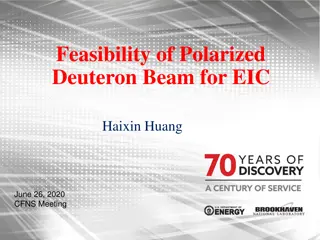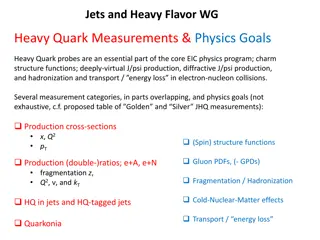Research on Services Reduction for EIC MAPS Tracker Detector
Investigating methods to reduce services load for EIC MAPS tracker detector focusing on powering, data aggregation, and overall optimization of technologies. Current status includes initial study on architectures for potential service reductions. Future plans involve detailed analysis, testing of DC-DC converter candidates, and research on existing powering schemes used by other experiments.
Download Presentation

Please find below an Image/Link to download the presentation.
The content on the website is provided AS IS for your information and personal use only. It may not be sold, licensed, or shared on other websites without obtaining consent from the author.If you encounter any issues during the download, it is possible that the publisher has removed the file from their server.
You are allowed to download the files provided on this website for personal or commercial use, subject to the condition that they are used lawfully. All files are the property of their respective owners.
The content on the website is provided AS IS for your information and personal use only. It may not be sold, licensed, or shared on other websites without obtaining consent from the author.
E N D
Presentation Transcript
Atmospheric System Research Overview for ACME Ashley D. Williamson Shaima L. Nasiri ASR Program Managers 5 June, 2017 ACME meeting Office of Science Office of Biological and Environmental Research
Atmospheric System Research (ASR) ASR uses ARM observations, lab studies, and process models to address key uncertainties in processes associated with clouds and aerosols that affect the Earth s radiative balance and hydrological cycle and limit the predictive ability of regional and global models. https://asr.science.energy.gov/ Department of Energy Office of Science Biological and Environmental Research 2
ASR + ACME ASR focuses on using observations to improve understanding of atmospheric processes Often at native scale Multiple connections to modeling: Development of new parameterizations Testing of existing parameterizations and process representation Determination of missing processes Refining scale relationships Making multiscale a reality ASR PIs are interested in ACME Open lines of communication Enable early adoption Department of Energy Office of Science Biological and Environmental Research 3
ASR is organized into four working groups The working groups represent ASR s current research priorities Aerosol Processes Working Group Nicole Riemer, University of Illinois Jim Smith, University of California, Irvine Warm Boundary Layer Processes Working Group Rob Wood, University of Washington Yunyan Zhang, Lawrence Livermore National Laboratory Convective Processes Working Group Anthony del Genio, NASA Goddard Institute for Space Studies Adam Varble, University of Utah High Latitude Processes Working Group Gijs de Boer, University of Colorado Department of Energy Office of Science Biological and Environmental Research 4
Aerosol processes working group The Aerosol Processes working group seeks to improve the understanding of processes governing the spatial and temporal distribution of atmospheric particles and their chemical, microphysical, and optical properties. The goal is to reduce the uncertainty in climate radiative forcing due to aerosols. Research topical areas include: 1. new particle formation, 2. the effects of aerosol composition, mixing state and physical properties on growth, aging, and removal processes 3. the direct and indirect radiative impacts of optically absorbing aerosols, and 4. identifying anthropogenic drivers that influence secondary organic aerosol concentrations and properties. Department of Energy Office of Science Biological and Environmental Research 5
Warm boundary layer processes working group The Warm Boundary Layer Processes working group seeks to improve understanding and model representation of processes controlling the structural and radiative properties of clouds, aerosols and their interactions with the underlying surface in the lowest few kilometers of the atmosphere. Research topical areas include: 1. characterization of boundary-layer and cloud dynamics, 2. cloud and aerosol microphysics and their interactions, 3. factors influencing cloud formation, and 4. radiative processes all of which together influence the vertical transfers of energy, moisture and atmospheric constituents. Department of Energy Office of Science Biological and Environmental Research 6
Convective processes working group The Convective Processes working group seeks to improve the understanding and model representation of convective cloud processes and properties including cloud cover, precipitation, life cycle, dynamics, and microphysics over a range of spatial scales. Research topical areas include: 1. convective vertical velocity and impacts on cloud microphysics and precipitation; 2. transitions in cloud populations and mesoscale organization of convection; and 3. interactions between cloud microphysics, aerosols, precipitation, and radiation. Research approaches involve both direct observations and retrievals of environmental and cloud properties, as well as process development and improvement of convective parameterizations across the hierarchy of models. Department of Energy Office of Science Biological and Environmental Research 7
High-latitude processes working group The High Latitude Processes working group improves understanding and model representation of physical processes controlling the surface energy budgets in northern and southern high latitude regions. This includes work to understand: 1. cloud micro- and macrophysical properties, including phase partitioning and ice crystal properties; 2. aerosol particle properties, including sources and transport, chemical and optical properties, and the role of aerosol particles in cloud structure; 3. tropospheric states, including the role of clouds in atmospheric mixing and the role of meteorology and surface conditions on thermodynamic evolution; 4. surface-atmosphere interactions, including elements impacting radiative and turbulent surface energy exchange. Department of Energy Office of Science Biological and Environmental Research 8
ASR Science Focus Areas at DOE Labs PNNL: Integrated Cloud, Land-surface, and Aerosol System Study (ICLASS) (new focus) BNL-ANL: Influence of Aerosol and Cloud Processes on Climate (new focus and collaboration) LLNL: SFA on Climate Change Research (joint SFA between RGCM and ASR) Department of Energy Office of Science Biological and Environmental Research 9
Phase diagrams for amorphous nanoscale organic aerosol Motivation High particle viscosity affects particle uptake of vapors, pollutant lifetime against oxidation or evaporation, and particle-cloud-climate interactions. Observations of particle viscosity transitions are needed to develop, constrain, and improve the representation of aerosol phase in large scale models. Approach Develop novel quantitative viscosity measurement method for submicron aerosols. Measure the temperature and RH onset of dimer coalescence to characterize the glass- to-liquid phase transition for particles. Develop and constrain simple physical chemistry models of the phase-state diagram for organic aerosol. For sucrose test aerosols, observed excellent agreement with macroscopic measurements. Amorphous phase diagram of 100 nm sucrose aerosol Impact Defines a measurement and modeling framework for future development of well-constrained aerosol phase diagrams suitable for inclusion in climate models. Extends viscosity measurements in the semi-solid regime to sub-200 nm particles. Approach can be applied to complex secondary organic aerosols. Reference: Rothfuss, N. E and M. D. Petters. 2016a. "Coalescence-based assessment of aerosol phase state using dimers prepared through a dual-differential mobility analyzer technique" Aerosol Sci. Technol. 12, 1294-1305, doi:10.1080/02786826.2016.1221050 ; 2016b. Characterization of the temperature and humidity-dependent phase diagram of amorphous nanoscale organic aerosol Phys. Chem. Chem. Phys. 19, 6532-6545, doi:10.1039/c6cp08593h Department of Energy Office of Science Biological and Environmental Research 10
Why do general circulation models overestimate the aerosol cloud lifetime effect? Objective Normalized (LWP) predicted by CAM simulations with different autoconversion rates (red) and in the CRM model (blue) at different horizontal resolutions. Observation-based studies have shown that the aerosol cloud lifetime effect may be overestimated in climate models. Determine the causes for increased liquid water path (LWP) in GCMs with increases in aerosols. Impact Approach Enhanced entrainment at cloud top in the CRM allows more evaporation, outweighing the effects of decreases in autoconversion and accretion processes, and keeping LWP relatively constant with aerosol concentration. Compare a cloud resolving model (CRM) to the CAM single column model for a case of observed low level clouds at the ARM SGP site. GCM models need to allow increased mixing of dry air from above with increases in aerosols. This requires both increased vertical resolution and a scheme to allow aerosol number to directly impact cloud top mixing. Use the LWP budget together with sensitivity studies to determine the causes of differences between the two models. Zhou, C. and Penner, J. E.: Why do general circulation models overestimate the aerosol cloud lifetime effect? A case study comparing CAM5 and a CRM, Atmos. Chem. Phys., 17, 21-29, doi:10.5194/acp-17-21-2017, 2017. Department of Energy Office of Science Biological and Environmental Research 11
First Climatology of Vertical Velocity in Amazonian Clouds Motivation Current GCMs do not represent deep convection over the Amazon well Observations of vertical velocity are needed to constrain and improve GCM parameterizations of deep convection Frequency of vertical velocity by altitude for all clouds (left) and those with tops above 12 km (right). Approach Impact 2 years of ARM radar wind profiler (RWP) data during GOAmazon are used to develop statistics on vertical velocities in Amazonian convection Data are averaged over 1 or 3 hours to correspond to model grid cells of 20 km or 60 km resolution Convective vertical velocity is related to corresponding environmental conditions Study provides the first climatology of vertical motion of Amazon clouds Stronger vertical velocity profile behaviors are seen under higher convective available potential energy (CAPE) and lower low-level moisture conditions Wet season regimes have higher domain-average mass flux profiles, attributed to more frequent convection that offsets weaker average convective cell vertical velocities Reference: Giangrande SE, T Toto, MP Jensen, M Bartholomew, Z Feng, A Protat, C Williams, C Schumacher, and L Machado. 2016. "Convective cloud vertical velocity and mass-flux characteristics from radar wind profiler observations during GoAmazon2014/5." Journal of Geophysical Research: Atmospheres, 121(21), 10.1002/2016jd025303. Department of Energy Office of Science Biological and Environmental Research 12
Rainfall during the Amazonian dry season is mainly controlled by non-local factors Cloud Fraction Cumulus Days Objectives Understand what controls the transition from shallow-to-deep convection and formation of precipitation during the Amazonian dry season. Determine why the number of precipitation events decreases as the dry season progresses. Cloud Fraction Rainy Days Approach Use data collected during the GOAmazon ARM campaign and contrast the diurnal cycles during 138 cumulus (no rain) days and 64 rainy days. Study the progression of key variables during the dry season in the context of local and non-local precipitation events. Impact Dry season daytime rainfall occurs during days with higher moisture content and cloudiness (figure) at low and mid-levels Total dry season rainfall is primarily determined by the propagating storm systems These factors can be incorporated into coarse resolution models to improve prediction of Amazonian dry season rainfall Ghate. V. P., and P. Kollias, 2016: On the controls of daytime precipitation in the Amazonian dry season. J. Hydrometeor., 17, 1379-1397. Department of Energy Office of Science Biological and Environmental Research 13
